accessible routes
Monday, August 4th, 2025
When are they required?
Most of us are aware that signage are required to meet the ADA accessibility standards at Interior signs designating permanent rooms, parking signs, and directional signs. These standards assist primarily persons that are visually impaired or have congnitive issues which can assist them in way finding as well as informing persons that use wheelchairs where the accessible route or designated wheelchair accessible areas are provided.
There are also signs that are not commonly known to require compliance. This newsletter will explain those instances.
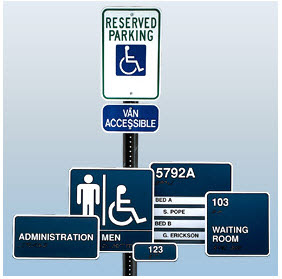
To assist persons with disabilities to find their way into and around the building, signage with certain requirements will have to be provided.
The signage above are required to be ADA compliant: Parking signs, restroom signs, permanent room signs.
Building directories, menus, seat and row designations in assembly areas, occupant names, building addresses, and company names and logos shall not be required to comply.
The Advisory of the ADA explains more about what “designations” are required to comply:
Advisory to Section 216.2 applies to signs that provide designations, labels, or names for interior rooms or spaces where the sign is not likely to change over time.
Examples include interior signs labeling restrooms, room and floor numbers or letters, and room names.
Tactile text descriptors are required for pictograms that are provided to label or identify a permanent room or space.
Pictograms that provide information about a room or space, such as “no smoking,” occupant logos, and the International Symbol of Accessibility, are not required to have text descriptors.
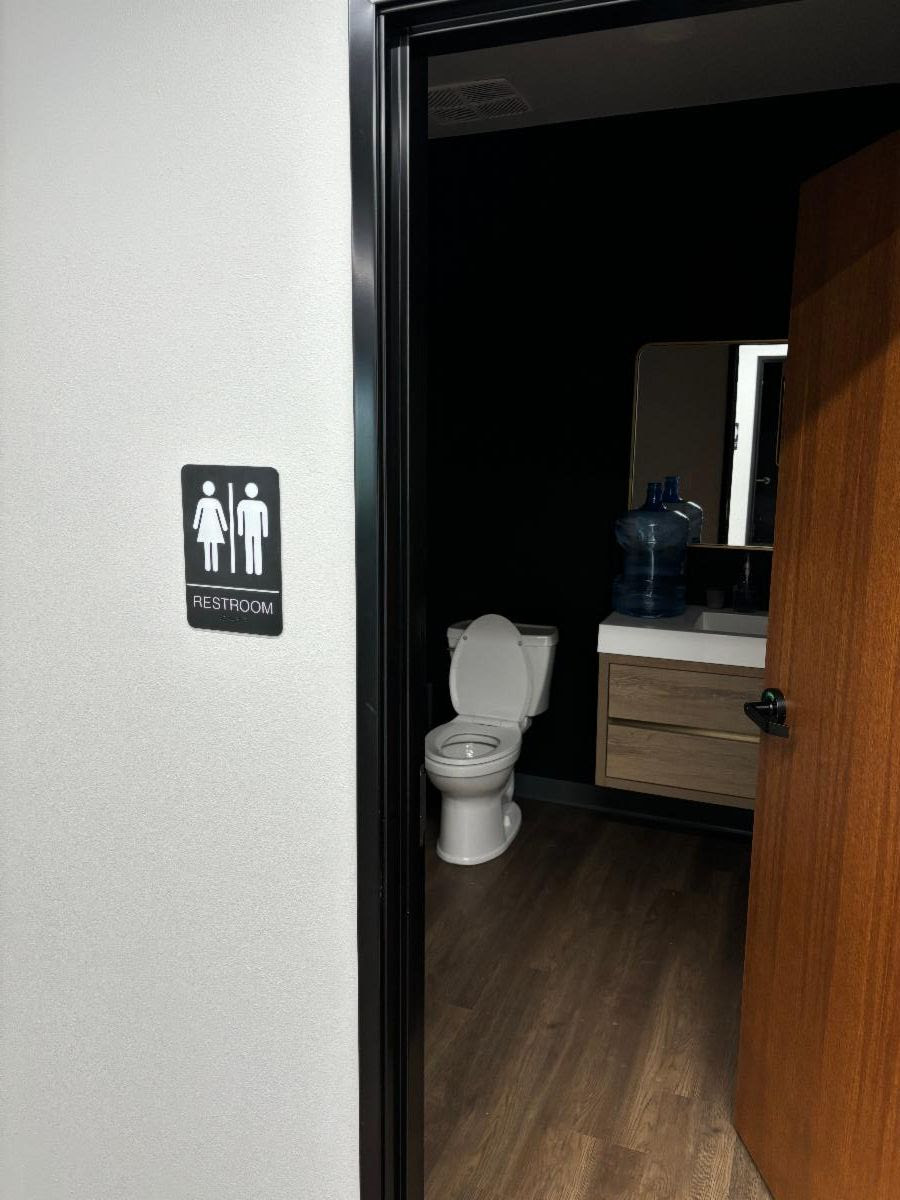
The sign shown in the photo above designates a restroom. The sign has a pictogram which has text describing what the pictogram is showing.
Signs that provide direction to or information about interior spaces and facilities of the site shall comply and have raised characters and braille. These signs are required even outside of rooms that are exempted, like machinery spaces. An electrical room may have a sign that provides information such as hazards found within. Even though the electrical room itself and the accessible route into the room are exempted, the sign is not and will have to be provided.
The advisory provides the following examples of what information will need to comply: “Information about interior spaces and facilities includes rules of conduct, occupant load, and similar signs. Signs providing direction to rooms or spaces include those that identify egress routes”
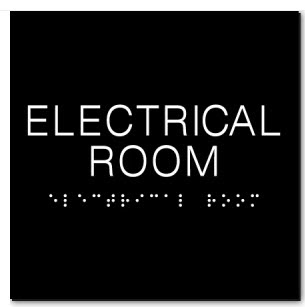
Electrical rooms and signage that informs people with visual impairements of hazards must provide braille and raised characters, even though the room itself is not required to comply.
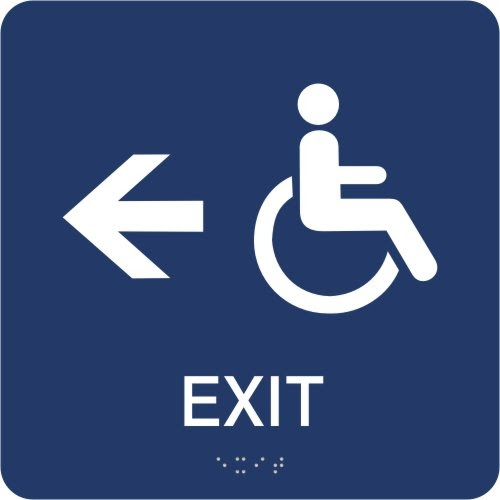
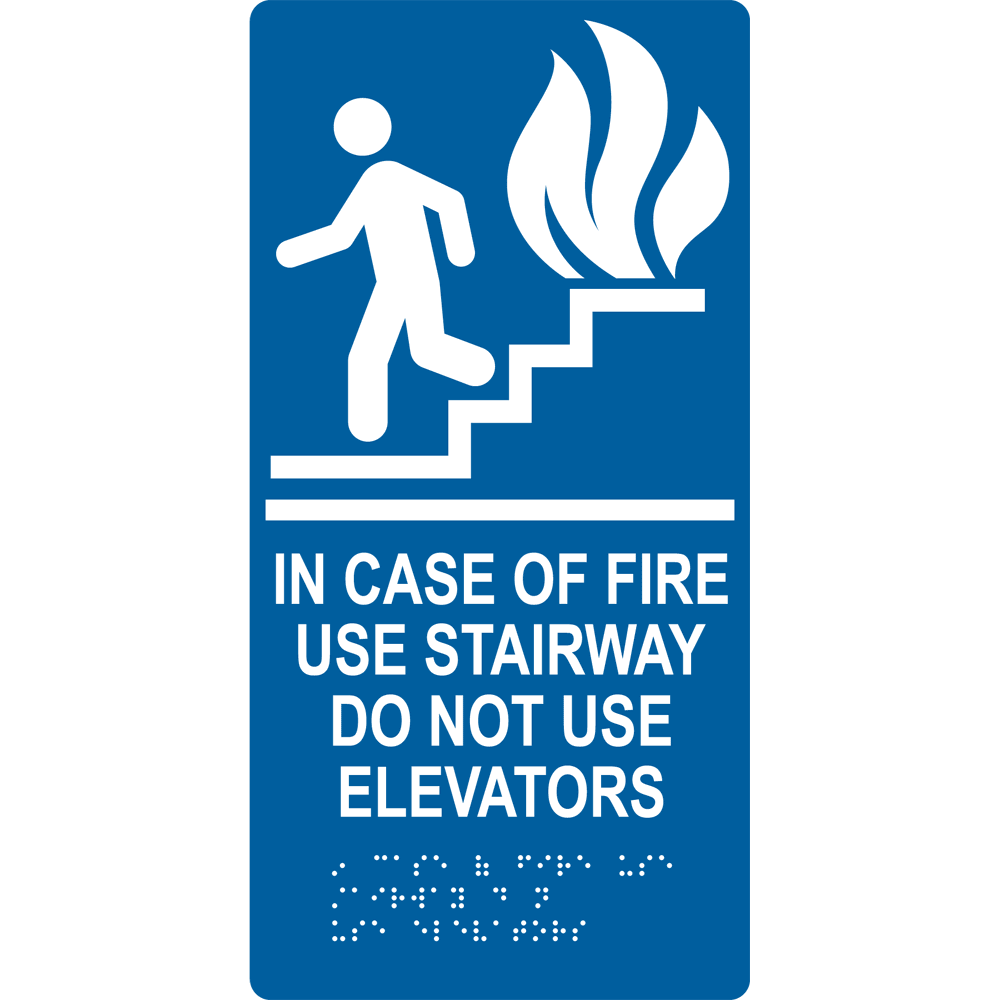
Signs providing direction to a required exit or to a means of egress will also be require to provide braille and raised characters.
RAISED CHARACTERS
Signs not only require braille, but raised characters. In the past couple of months, I have encountered signage with sunken letters, rather than raised. The Standards requires a certain height above the background:
703.2.1 Raised characters shall be 1/32 inch (0.8 mm) minimum above their background.
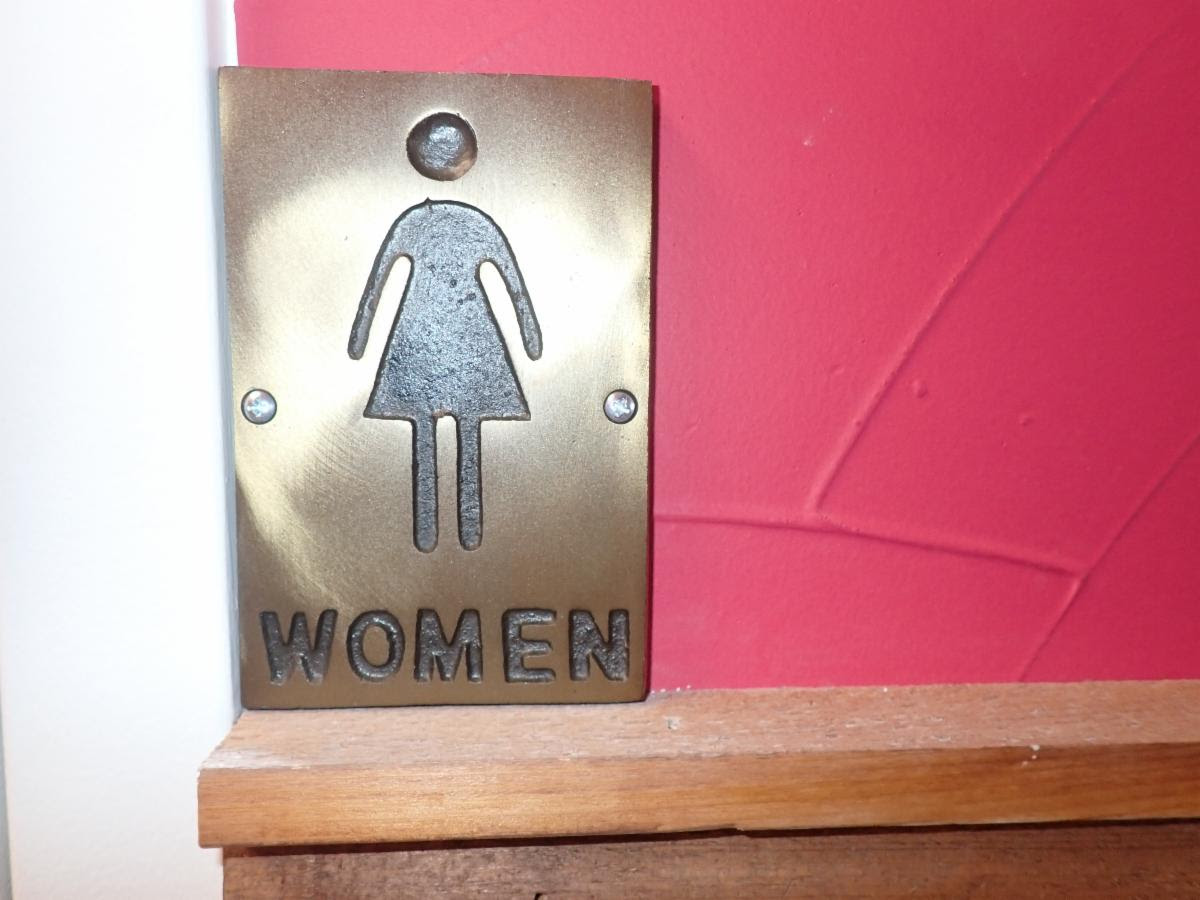
The restroom signs shown above had sunken letters, not raised, and no braille was provided below the words
LOCATION OF SIGNAGE
I have also received several questions lately about the location of signs. Signage should be located in the following locations by section 703.4.2:
1. Where a tactile sign is provided at a door, the sign shall be located alongside the door at the latch side.
2. Where a tactile sign is provided at double doors with one active leaf, the sign shall be located on the inactive leaf.
3. Where a tactile sign is provided at double doors with two active leafs, the sign shall be located to the right of the right hand door.
4. Where there is no wall space at the latch side of a single door or at the right side of double doors, signs shall be located on the nearest adjacent wall.
5. Signs containing tactile characters shall be located so that a clear floor space of 18 inches (455 mm) minimum by 18 inches (455 mm) minimum, centered on the tactile characters, is provided beyond the arc of any door swing between the closed position and 45 degree open position.
6. Signs with tactile characters shall be permitted on the push side of doors with closers and without hold-open devices
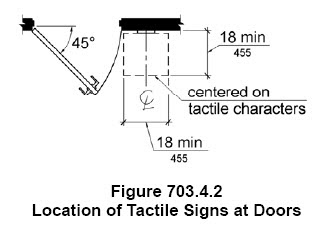
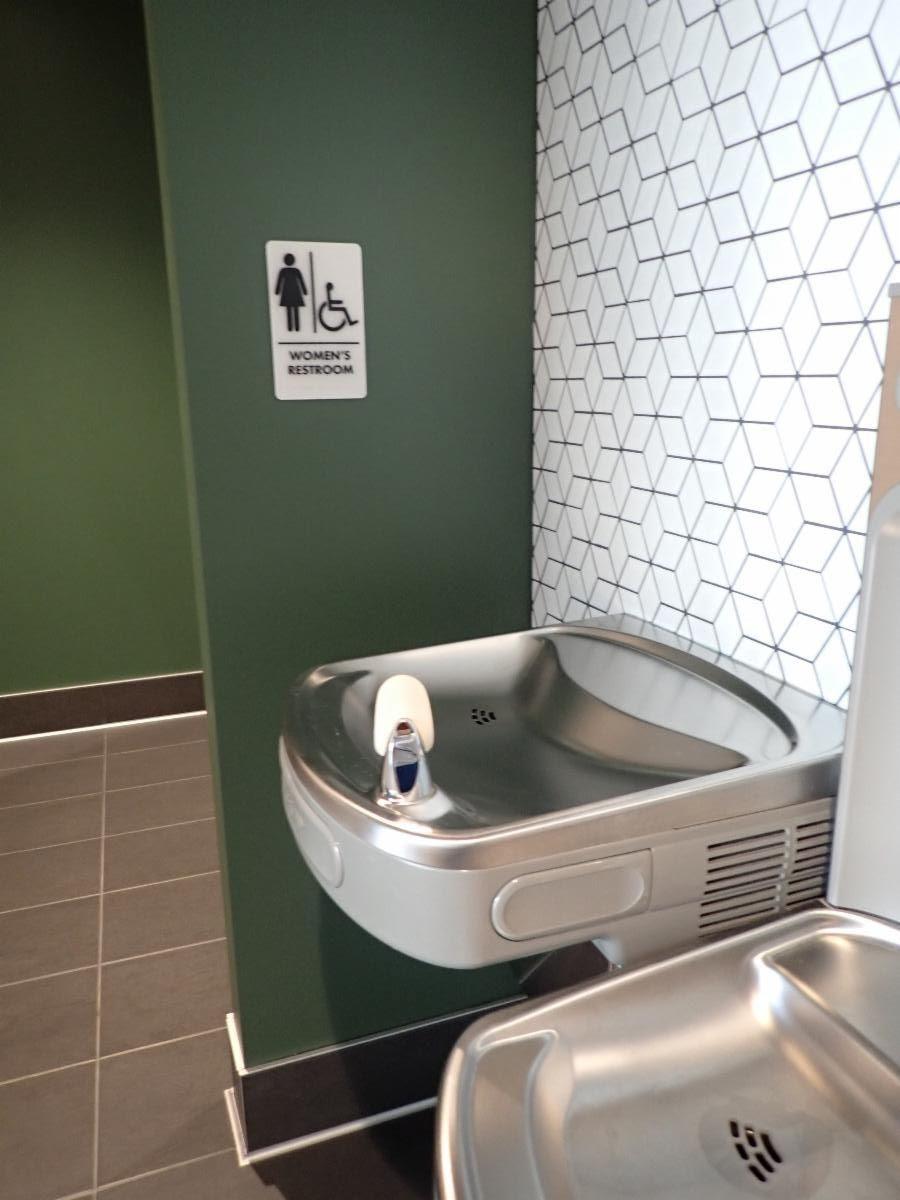
The restroom signs shown does not have the 18″x18″ at the floor required for reading the sign

The image above depicts how a person that is visually impaired will use the 18″x18″ space to read the sign.
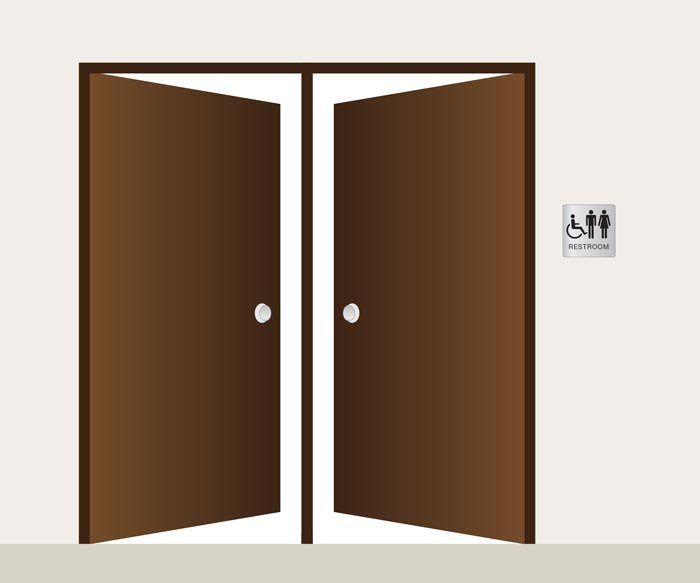
The image above depicts a double door with two active leaves. The sign shall be located on the right side of the right hand door.

The image above depicts a double door with one active leaf. The sign shall be located on inactive door.
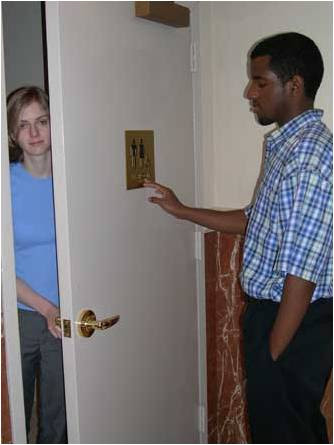
The photo above shows a sign on the pull side of the door. This would be a hazard to the person trying to read the sign as the door is being opened. Signs are allowed to be located on a door ONLY if it has both a closer and on the push side
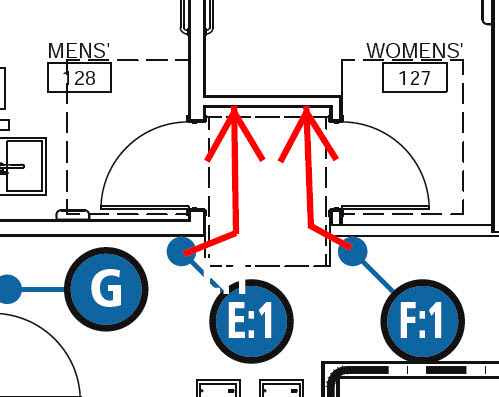
The image above shows a vestibule for the restrooms. Since there is not enough room for a sign to be located on the latch side, it is allowed to be located on the adjacent wall.

when there is no room adjacent to the latch side and it is allowed to be located on the adjacent wall, be sure that it is beyond the swing of the door.
Need a “Barrier Free” HSW AIA approved CEUs?
August 19th – “Applying the ADA to Existing and Altered Buildings” at Tangram Interiors, 300 South Pearl Expressway, Suite 200, Dallas. CU begins at noon
Link to Register: https://iida.ejoinme.org/dalaug25ceureg
September 9th – “The ADA and Residential Facilities” at Kimball’s Downtown Showrrom, 1699 Cedar Springs Road, Dallas 75201
Link to Register: https://iida.ejoinme.org/dalsep25ceu
Tuesday, July 1st, 2025
One of the common violations I find during my accessibility inspections are reach ranges to operable parts. There seems to be a misunderstanding about this rule. The rule allows a person with disabilities to reach elements they need to operate: light switches, latches at first aid cabinets, or charging outlets, for example.
The requirement for a forward approach that is not obstructed are that the operable part be mounted no lower than 15″ a.f.f. or no higher than 48″ a.f.f.

At one of my inspections I found several light switches that were mounted higher than 48″ to the operable part. Below is an example of a rocker switch.
Some electricians believe that the rule is meant to be a maximum to the middle of the junction box, but that would be a violation since the rocker switch has its uppermost operable part higher than the middle.

The light switch shown above is mounted 53″ a.f.f. to the top of its operable part
At several of inspections I noticed that there have been Cintas First Aid cabinet mount on the walls of office spaces. This cabinet has two latches on the side to open and close. There is one mounted at the bottom of the box and there is a second one closer to the top of the box to open the lid. The bottom latch was mounted at the 48″ a.f.f. maximum but the top one is beyond the reach range. Since the lid will not open unless both operable parts are unlatched, both latches must be within reach.

The Cintas first aid center was mounted so that the top operable part to open the box was mounted higher than the maximum 48″ a.f.f.

The top latch was mounted at 68″ a.f.f.
It has become popular to have charging outlets in different places along lobbies, corridors and break rooms. One of the places that I see them installed are on banquettes in common areas installed at the base of the banquette. Those will also have to be within reach.

Banquette with a charging outlet at a common area in an office building

The outlet was mounted at 10 1/2″ a.f.f. to the operable part rather than the 15″ a.f.f. minimum required by the Standards
Need a “Barrier Free” HSW AIA approved CEUs?
July 15th – “How Accessible is Your Workplace” at Herman Miller Showroom 2811 McKinne Avenue Suite 18 Dallas Tx at 12:00
August 19th – “Applying the ADA to Existing and Altered Buildings” at Tangram Interiors, 300 South Pearl Expressway, Suite 200, Dallas. CU begins at noon
Link to Register: https://iida.ejoinme.org/dalaug25ceureg
September 9th – “The ADA and Residential Facilities” at Kimball’s Downtown Showrrom, 1699 Cedar Springs Road, Dallas 75201
Link to Register: https://iida.ejoinme.org/dalsep25ceu
Tuesday, April 1st, 2025
Ranges, Maximums minimums and tolerances in the 2010 ADA Standards
The ADA Standards has requirements of how tall, how low, how long elements should be for them to be usable for persons with disabilities. These ranges and limits are typically noted as either absolutes, maximums or minimums. This newsletter will explain why, as designers, it is not recommended to note the maximums and minimums in our drawings.
Here is a video that explains the concept.
Door Maneuvering Clearance
One of the examples I want to discuss are door maneuvering clearances. Section 404 has requirements for clearance to open and go through the door using a wheelchair. The clearances listed in the section are noted as minimums, which implies that it is the lowest limit and should be larger than the number listed.

The figure above is the pull side approach which requires an 18″ MINIMUM clearance at the strike side of the door to pull the door open.
Our practice as design professionals is to note 18″ min. on the drawings or as a note, which will not provide construction tolerances. During my inspections, one of the common violations is when the door clearance is a few fractions of an inch less than the minimum required clearance.


The photo above shows a 17 1/2″ clearance at the latch side of the door not the MINIMUM 18″ due to construction mistakes or restrictions
Heights of Sinks and Lavatories
Per section 606 of the ADA, sinks and lavatories must be mounted so that the rim is no higher than 34″ a.f.f.
606.3 Height. Lavatories and sinks shall be installed with the front of the higher of the rim or counter surface 34 inches (865 mm) maximum above the finish floor or ground.
Many times, design professionals tend to use the 34″ a.f.f. as our dimension which again does not allow for any construction mistakes.

The drawing of the sink section shows all the dimensions as absolutes and does not allow for any construciton mistakes


The photo above shows a sink that is mounted higher than 34″ a.f.f.
Reach to operable parts
In section 308 and 309 the ADA provides guidelines on how high and how low the operable parts must be mounted. Design professionals, including electircal engineers, have a tendency to draw using the 48″ as a go by for elements.

The figure above is the ADA reach range for a forward approach. The reach is intended for operable parts and elements that we operate or use

The light switch above was mounted at 48 1/2″ a.f.f. which is higher than the minimum allowed reach.

Some electricians are taught that the 48″ is measuring the centerline of elements. At inspections I find that many switches are mounted 48″ to the center line of the junction box. The photo above shows a rocker switch which has its operable part at the top of the switch. It was mounted to the centerline which is not the operable part.
Tolerances in the ADA
The ADA does allow for tolerances, but it is vague in the allowable ranges for those.
ADA section 104.1.1 States:
“Construction and Manufacturing Tolerances. All dimensions are subject to conventional industry tolerances except where the requirement is stated as a range with specific minimum and maximum end points.”
Therefore if the figure has the words maximum and minimum or if it lists a range, The DOJ believes that the tolerances are already built in and industrustry standards for other tolerances may not be used.
Tuesday, March 4th, 2025
The 2010 ADA Standards for Accessible Design are only minimum requirements to ensure that the facility will be, to the maximum extent feasible, be readily accessible to and usable by individuals with disabilities.
What that means is that the requirements are a base line for how to make buildings accessible, and if something better or more accessible can be provided, that would be ideal.
As an inspector, I cannot tell my architects and owners to do more than the minimum, but this newsletter will give guidance on elements that may not be required, but would be a good practice to provide.
Wheel Stops
Wheel stops are not required by the ADA standards. The minimum requirement is that the sidewalks and parking should be desiged as to prevent the parked cars from reducing the clear width of the accessible route:
ADA Section 502.7 Relationship to Accessible Routes. Parking spaces and access aisles shall be designed so that cars and vans, when parked, cannot obstruct the required clear width of adjacent accessible routes
Wheel stops are a good way to prevent the cars and vans from obstructing the clear width of the accessible route.

The photo above shows an accessible route located in front of the parking spaces, and because there are no wheelstops the front of the parked car is partially obstructing the route.

The photo above shows parked cars that are obstructing not only the walking surface but also the curb ramps that are part of the accessible route. Wheel stops would prevent it.
Benches at Shower rooms
The ADA Standards section 803 requires that dressing, fitting and locker rooms provide a bench.
ADA Section 803.4 Benches. A bench complying with 903 shall be provided within the room.
As an inspector I find that design professionals think they need to have a bench at shower rooms. Technically the shower rooms would be a place to undress in order to take a shower, but it is not considered a “dressing room”. Therefore a shower room is not required to have a bench as stated in section 803.
Even though it is not required, a bench in the shower room would be a good practice to provide, since the likelyhood of a person with disabilities to need to undress in order to use the shower would be high, the bench would be helpful.
For information: A bench is different than a shower seat

The drawing above shows a locker room with showers. Because this is a locker room, a bench is required in this room.

The drawing above shows a shower room. Even though there is a bench shown in the shower room, it is not required.

The photo above shows a bathing room without a bench.
Power Assisted doors
Exterior doors are not required to have an opening force more than 5 lbs. That requirement is only for interior swing doors. But exterior swing doors might be difficult to open due to the wind pressure or other factors that are not within out control. One way to provide assistance with difficult doors is to install power assisted doors. They are not required, but if used they must comply.
Even though a power assisted door is not required by the ADA Standards, it would be a good practice to provide one in order to assist persons with disabilities to open exterior doors.

The photo above shows a power assisted mechanism on the exterior entrance in order to provide assistance for persons with disabilities to open the door.
34″ a.f.f. Counter Heights
There are two different requirements at fixed counters depending on what they are used for.
Section 902 requires that a fixed dining or non-employee work surface be mounted at 34″ a.f.f.
Section 904 on the other hand has a requirement that the fixed sales or service counters be mounted at 36″ a.f.f.
As an inspector I find violations when the fixed dining counters are mounted higher than 34″ a.f.f. or the fixed sales or service counters are mounted higher than 36″ a.f.f.
In order to avoid this it would be recommended to mount all counters at 33″ a.f.f. therefore they will be meet both requirements.

The fixed dining counter shown in the photo above is required to be mounted a maximum of 34″ a.f.f.

The fixed ticket counter shown in the figure above is considered a “sales and service counter” and will be required to be mounted a maximum of 36″ a.f.f.

The movable reception counter is not required to provide an accessible portion since it is considered furniture, but it would be good practice to provide one so that a person with disabilities will be able to approach it and utilize it.
Thursday, September 1st, 2022
Part 2
We have been discussing when we should make our clear floor space centered on the elements. This is a continuation of the commercial guidelines outlined in the ADA. For Part 1 refer to the
August Newsletter.Below are some other instances that the ADA will require that there be a clear floor space that is centered.
Residential Kichen Work Surface
In kitchens of residential dwelling units (not located in multi-family housing, but required by section 233 to be accessible, there is a requirement to provide a “work surface” with a knee clearance with a floor space centered and allowing a forward approach.
804.3 Kitchen Work Surface (Residential only)
804.3.1 Clear Floor or Ground Space. A clear floor space complying with 305 positioned for a forward approach shall be provided. The clear floor or ground space shall be centered on the kitchen work surface and shall provide knee and toe clearance complying with 306.
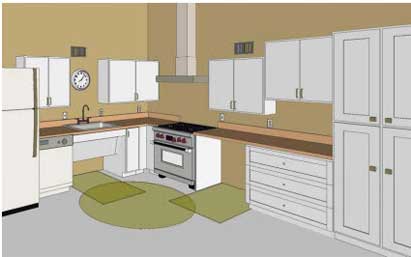
The image above shows a residential kitchen with a sink as well as a “work surface” which provides a forward approach. The work surface is required that the clear floor space below it be centered at the surface. The sink is not required to provide a clear floor space that is centered.
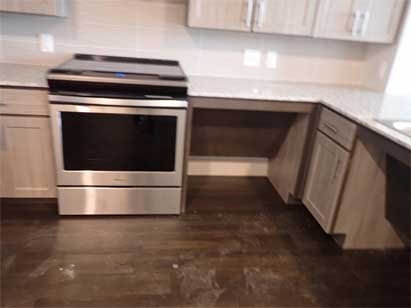
The image above shows a residential kitchen work surface and it is centered at the surface.
Altered Sales and Service counter
When an existing sales and service counter is altered, they must provide an accessible portion. Typically a sales or service counter must be 36″ long minimum, but if they cannot accommodate that length they would be allowed to only provide a 24″ counter as long as there is a clear lfoor space centered and parallel to the counter.
904 Sales and Service counters
904.4 Sales and Service Counters.
EXCEPTION: In alterations, when the provision of a counter complying with 904.4 would result in a reduction of the number of existing counters at work stations or a reduction of the number of existing mail boxes, the counter shall be permitted to have a portion which is 24 inches (610 mm) long minimum complying with 904.4.1 provided that the required clear floor or ground space is centered on the accessible length of the counter.
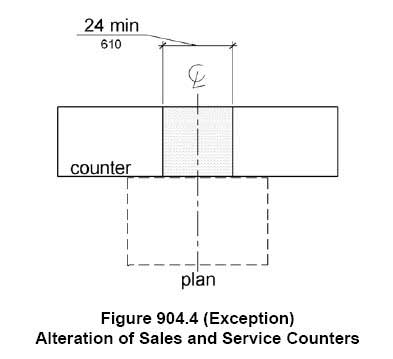
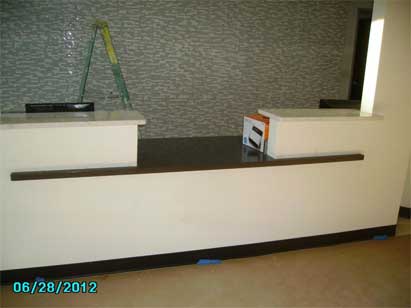
The image above shows an example of a counter which has a parallel approach at the lower counter and the clear floor space is also centered at the accessible portion. The length is unknown, but this would be an example of how the exception could be taken.
Playground transfer system
When playgrounds have elevated components that require an accessible route, one way that they can reach the elevated portion is via a transfer system. That transfer system will also require to have a parallel clear floor space centered at the platform.
1008.3Playground Transfer Systems
1008.3.1.3 Transfer Space. A transfer space complying with 305.2 and 305.3 shall be provided adjacent to the transfer platform. The 48 inch (1220 mm) long minimum dimension of the transfer space shall be centered on and parallel to the 24 inch (610 mm) long minimum side of the transfer platform. The side of the transfer platform serving the transfer space shall be unobstructed.
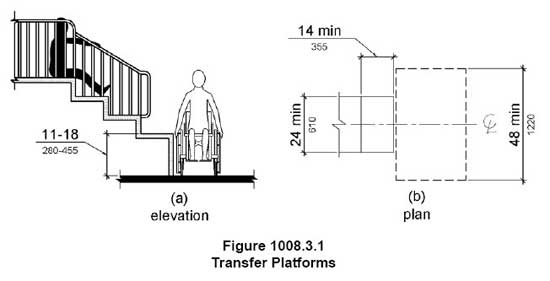
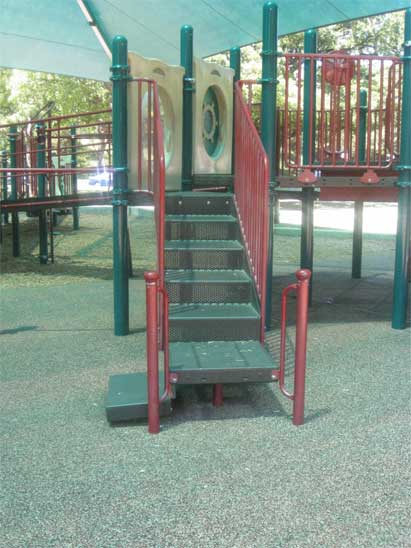
The image above shows a transfer system at an elevated play structure. There is room for the clear floor space to be centered at the platform.
Pool transfer walls and platforms
Pools and spas (jacuzzis/hot tubs) are required to have an accessible entry (or two depending on the size of the pool). There are several options for the accessible entry. One is a transfer wall and another a transfer platform. The transfer wall or the transfer platform must have a clear floor space centered at the deck to assist with entry to the pool.
1009.4 Pool Transfer Walls
1009.4.1 Clear Deck Space. A clear deck space of 60 inches (1525 mm) minimum by 60 inches (1525 mm) minimum with a slope not steeper than 1:48 shall be provided at the base of the transfer wall. Where one grab bar is provided, the clear deck space shall be centered on the grab bar. Where two grab bars are provided, the clear deck space shall be centered on the clearance between the grab bars.
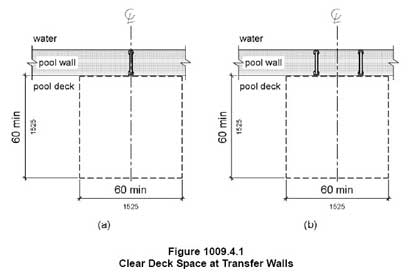
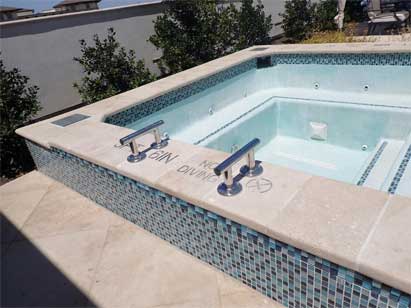
The image above shows a transfer wall with two grab bars at a jacuzzi. There is room for the clear floor space to be centered between the two grab bars.
1009.5 Pool Transfer Platform
1009.5.2 Transfer Space. A transfer space of 60 inches (1525 mm) minimum by 60 inches (1525 mm) minimum with a slope not steeper than 1:48 shall be provided at the base of the transfer platform surface and shall be centered along a 24 inch (610 mm) minimum side of the transfer platform. The side of the transfer platform serving the transfer space shall be unobstructed.
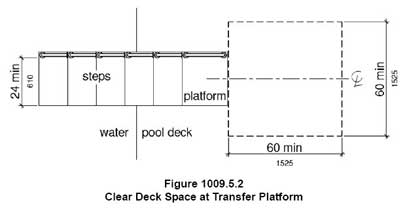
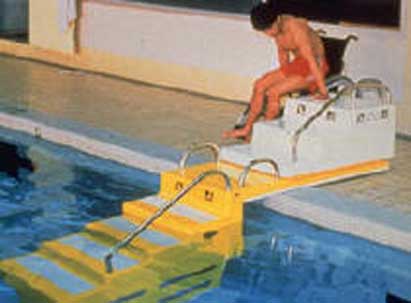
1) Texas Association of Interior Design
Ludowici Dallas Design Center | 133 Manufacturing St, Dallas, TX 75207
Monday, August 1st, 2022
Part 1
In the 2010 ADA and the 2012 Texas Accessibility Standards there are certain elements that require front approach and centered clear floor space on the element, but not all of them do. This newsletter will enumerate the one’s that do. Other elements such as lavatories and sinks only require forward approach but the clear floor space is not required to be centered.
Below are the elements that require a clear floor space to be centered:
Drinking fountains
Drinking fountains are one of the elements listed in the ADA and TAS that require that the wheelchair drinking fountain have a clear floor space centered on the unit. The clear floor space must also be a forward approach.
602 Drinking Fountains
602.2 Clear Floor Space. Units shall have a clear floor or ground space complying with 305 positioned for a forward approach and centered on the unit. Knee and toe clearance complying with 306 shall be provided
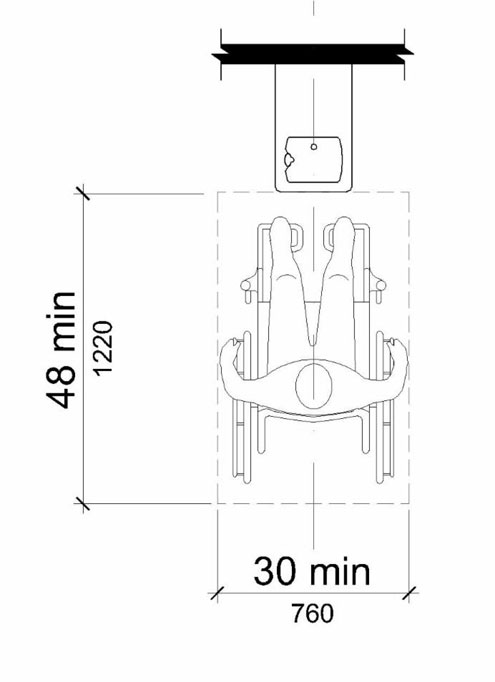
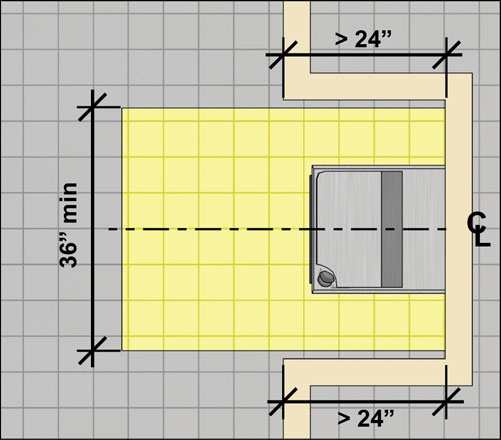
The image above shows the required clear floor space at the drinking fountain. It must be a forward approach and it must be centered on the wheelchair accessible drinking fountain. If it is located at an alcove deeper than 24″ the clear floor space must be widened to 36″ wide.
There are two violations that occurr with this requirement. One is that sometimes the drinking fountains are located along a corridor and not in an alcove. This creates a protruding object issues (see this newsletter that explains that). In order to resolve the protruding object, a cane dectable apron is sometimes installed at the bottom of the “high” drinking fountain and the apron reduceds the ability to have a forward approach because it might be lower than 27″ a.f.f.
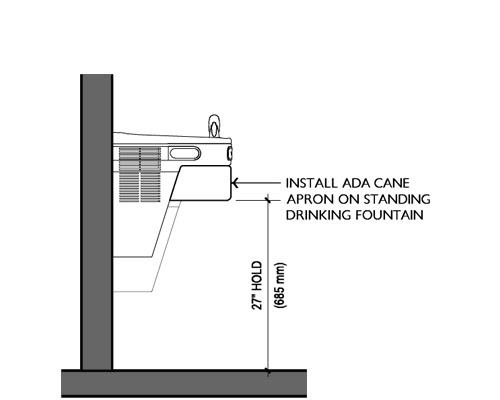
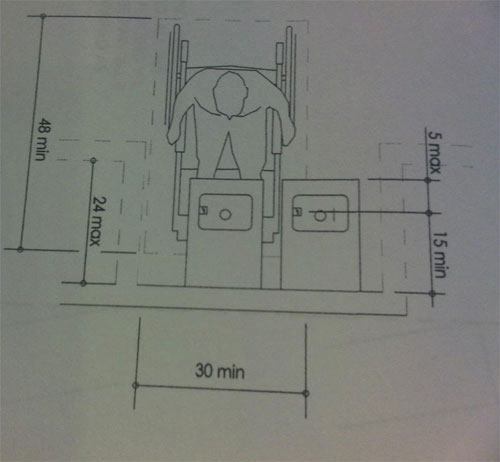
The image above shows how the clear floor space centered under the “low” drinking fountain spans below the “high” one and if there is an apron below the 27″ a.f.f. it will prevent the use of the drinking fountain by a wheelchair.
Number two is that sometimes the drinking fountains are located in an alcove and the walls creating the alcove reduce the 30″ clearance which must be centered. The wall adjacent to the wheelchair accessible drinking fountain should be a minimum distance of 15″ from the centerline of the drinking fountain to the inside of the wall.
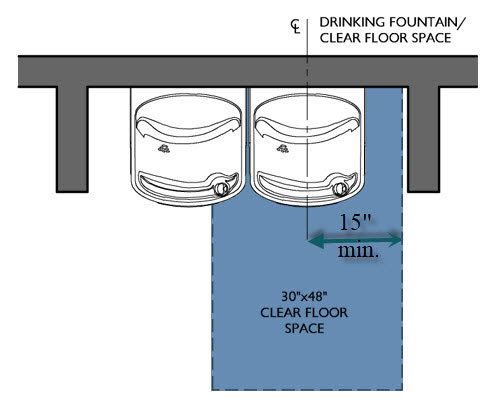
The image above shows how the clear floor space centered under the “low” drinking fountain must be a minimum of 15″ from the center of the drinking fountain to the inner edge of the alcove.
Washer and Dryer
The washer and dryer must also have the clear floor space centered on the appliance and must have parallel approach.
611 Washer and Dryer
611.2 Clear Floor Space. A clear floor or ground space complying with 305 positioned for parallel approach shall be provided. The clear floor or ground space shall be centered on the appliance.
This sometimes causes issues if the washer and dryer are located inside a closet. The doors may reduce the clearance.
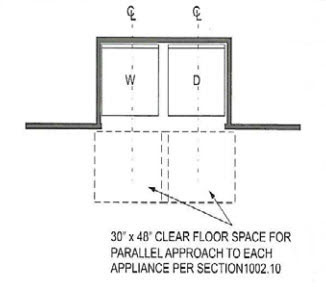
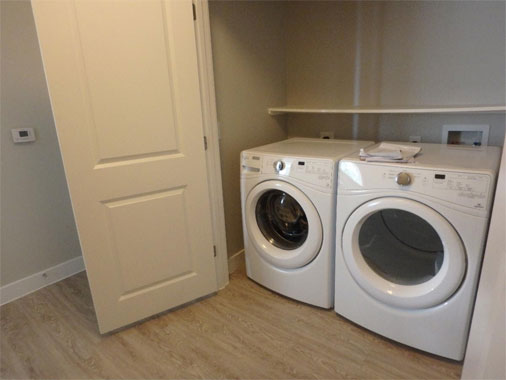
The image above shows a set of washer and dryer located inside a utility closet. The doors do not open 180 degrees and reduce the clear floor space to less than 24″ from the centerline of the dryer to the edge of the floor space.
Signage
The signage that designate permanent rooms must have an 18″x18″ clear floor space centered on the sign.
703 Signage
703.4.2 Location. ….Signs containing tactile characters shall be located so that a clear floor space of 18 inches (455 mm) minimum by 18 inches (455 mm) minimum, centered on the tactile characters, is provided beyond the arc of any door swing between the closed position and 45 degree open position.


The image above shows a sign which has a drinking fountain in front of it, therefore the requirement for a clear floor space centered on the sign has not been met.
Lavatories and Sinks
One of the misconceptions is that a clear floor space at the sink or lavatory is required to be centered. The approach must be forward, but the clear floor space is not noted as needing to be centered, like the other sections do. Therefore by omission we understand that the clear floor space can be offset.
606 Lavatories and Sinks
606.2 Clear Floor Space. A clear floor space complying with 305, positioned for a forward approach, and knee and toe clearance complying with 306 shall be provided.
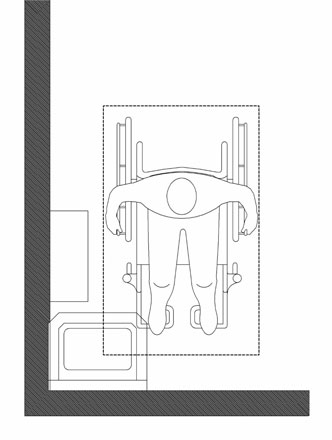
The image above shows a wheelchair clear floor space that is not centered at the lavatory. The clear floor space under the lavatory can be offset if there is an obstruction such as a paper towel dispenser next to the lavatory.
Wednesday, June 1st, 2022
Introduction:
Accessible signage can be a very confusing topic. Even after all these years of practicing my accessibility consulting, I am still learning a thing or two. Sadly they can even be confusing to signage manufacturers and installers.
Accessible signs require the following things:
- Raised and Brailled Characters
- Contrasting background
- San Serif Fonts
- If using Pictogram, there are requirements
- If depicting accessible spaces the use of the ISA (International Symbol of Access)
This newsletter will focus on a few common errors I encounter during my inspections.
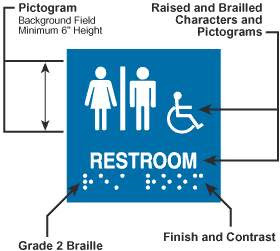
Raised Characters
The accessible signage will require that the characters describing the space whether it be a number or letters, must be raised. They should be at least 1/32″ above the surface of the sign.
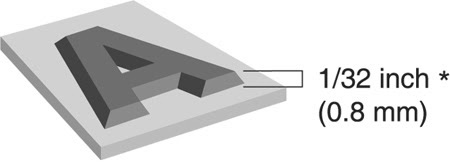
This graphic shows the minimum requirement for the raised characters of a sign.
There should also be Braille below the words that states the same words that are provided. So all words and numbers should be duplicated by Braille
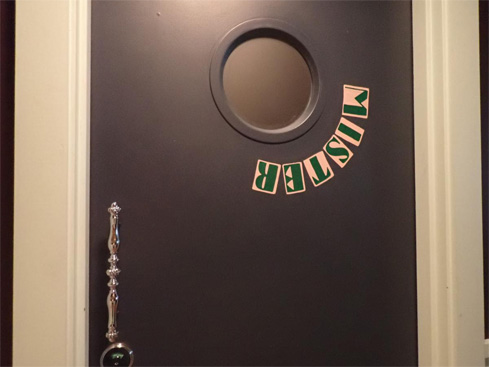
The restroom had a painted sign on the door but the characters were not raised and it did not have brailled as a duplicate. This is not compliant
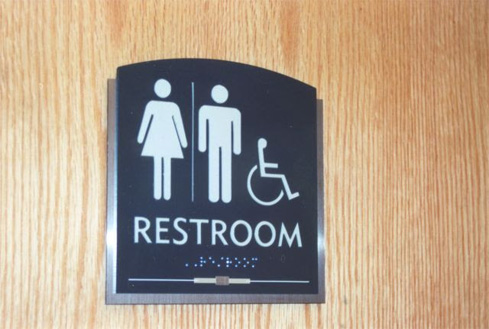
The restroom sign has both raised letters and characters and braille duplicated below the words. This is a compliant sign..
Pictograms
What are pictograms? It is a figure that represents the words of the sign. Pictograms are not required, but if you use them the field they are in should be 6″ minimum. The pictogram can be smaller than that, but the field must be at least 6″ tall.

Pictograms must be located ABOVE the words they are describing. Per section 703
703.6.3 Text Descriptors. Pictograms shall have text descriptors located directly below the pictogram field. Text descriptors shall comply with 703.2, 703.3 and 703.4.
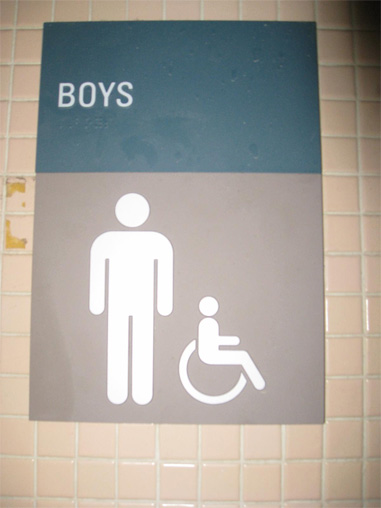
The pictogram at this sign is located below the words describing it. That is not compliant
Monday, May 2nd, 2022
Introduction:
Changes to the Texas Accessiblity Standards have been proposed and are open for public comments. The new standard, once adopted would be called The 2022 Texas Accessibility Standards.
This newsletter will give you a few proposed changes. These have not been adopted yet, and if you have any comments for TDLR before they implement them, the comments will be accepted until May 9th, 2022 using this link
2022 Texas Accessibility Standards Changes
Here are a few of the changes that are being proposed:
1. Outdoor Developed Areas. There will be a brand new chapter for Outdoor developed areas, Section 245 and Chapter 11. These will include trails, beaches, camping and picnic areas (just to name a few).
2. Advisory. Many of the advisories have become part of the Standards
3. Definition of Alteration. The definition of “alteration” has change slightly to include clarification on “circulation paths”. It now includes flooring as part of the definition:
106.5.5 Alteration. A change to a building or facility that affects or could may affect the usability of the building or facility or portion thereof. Alterations include, but are not limited to, remodeling, renovation, rehabilitation, reconstruction, historic restoration, resurfacing of circulation paths or vehicular ways including carpets, floors, or fields, changes or rearrangement of the structural parts or elements, and changes or rearrangement in the plan configuration of walls and full-height partitions.
Normal maintenance, reroofing, painting or wallpapering, or changes to mechanical and electrical systems are not alterations unless they affect the usability of the building or facility
The exemption for employee work areas clarified what “approach, enter and exit” means
203.9 Employee Work Areas. …..
“Approach, enter, and exit” means that people using wheelchairs must be able to enter and back out of the space. Employee work area doors, doorways, and gates, therefore, must comply with TAS 404 except the maneuvering clearance is limited to the “enter” side unless required for egress by TAS 207.1.
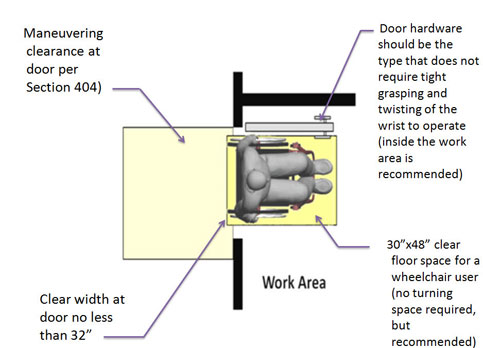
The picture above shows the diagram which explains the requirements for a work area entrance.
4. Licensed Physical and Occupational Therapy spacesused to have to go through a variance process in order to allow them not to be accessible. The proposed changes makes them not required and will no longer need a variance.
203.15 Licensed Physical and Occupational Therapy Training Areas Including Bathrooms and Kitchens. Licensed provider areas that are purposefully inaccessible for the intent of training persons with disabilities to function in a simulated home environment for when they leave therapy and return home shall not be required to comply with accessible features. The user must be able to get to the area but may not necessarily be required to provide an accessible route within the space for training purposes.
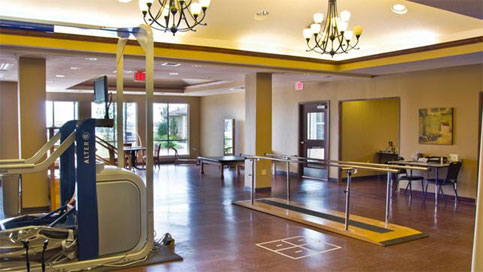
Physical Therapy areas will no longer require a variance not to comply
5. Electrical Vehicle Charging Stations. TDLR has issued many Technical Memos throughout the years. The 2022 TAS will incorporate some as part of the standards. One of them is about Electrical Vehicle parking and charging spaces. The requirements will now be part of the 2022 TAS in section 244, 208 and 502.
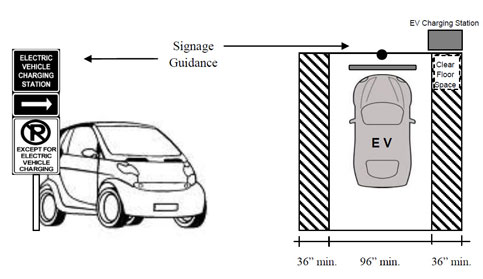
This is the requirements from the Technical Memo for Electrical Vehicle Charging Stations. They will now be part of the new standards
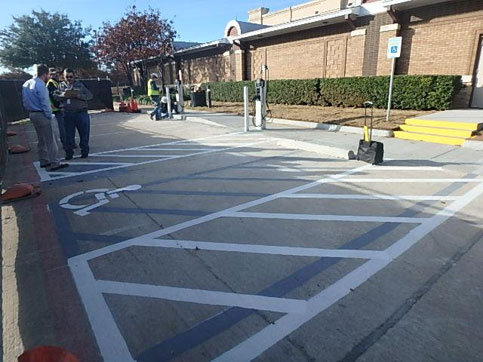 .
.
A built example
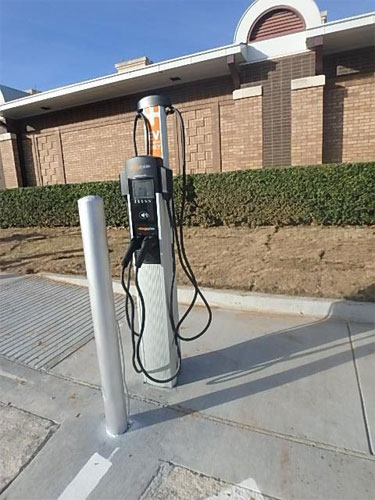
A charging station. The 2022 TAS will require a clear floor space to reach the accessible one.
6. 208.1 Parking Facilties. TDLR has clarified that parking facilities that are served by valet parking are not exempted from compliance with 208 and must have accessible parking.
7. Curb ramps at public right of way. THEY’RE BACK!!! Detectable warnings (truncated domes with contrasting color) are being proposed to come back on the Standards. Don’t kill me!
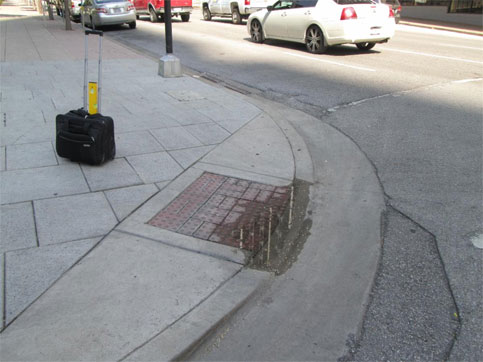
curb ramps located within the public right of way are proposed to have detectable warnings.
Be sure you get involved in the public comments. We need your voices and opinions to be heard to ensure that the Standards are clear and are providing proper guidance for design professionals so we can design and build environments for persons with disabilities that are inclusive and safe.
Friday, April 1st, 2022
Introduction:
If you have been around for a minute in the building industry you have seen our esteemed “truncated domes” come and go, and come and go…well it happened again….When the ADAAG was published in 1991, there was a section called “Detectable Warnings”. These were elements used for people that were visually impaired to assist them in navigating their exterior environment. A detectable warning had texture and contrasting color so a person who used a cane could feel the texture as he walked and maybe if they had low vision they could detect a change in color. Both of these methods allowed them to be aware that there might be a hazard on its way.
The detectable warning texture was required to be “truncated domes” located at a curb ramp and later it was added to pedges at a train track platforms.
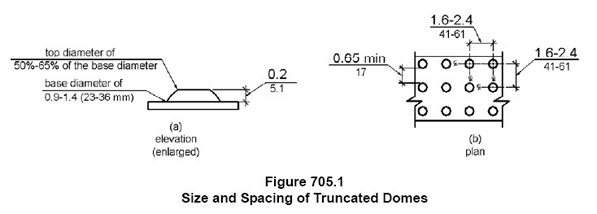
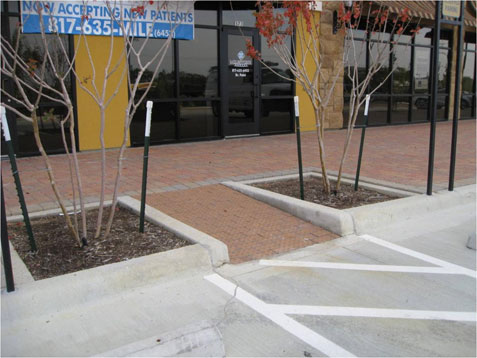
This is a curb ramp inside the property line with detectable warnings.
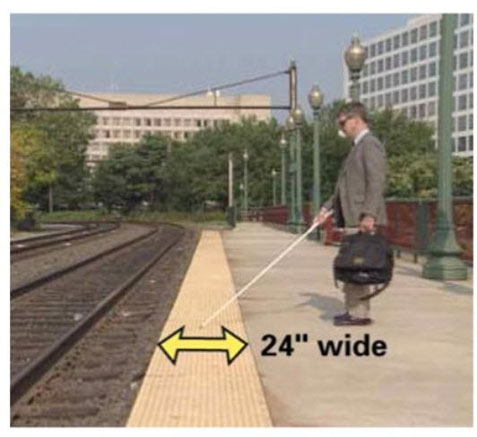
This is a train platform edge with detectable warnings.
The ADA Standards for Accessible Design and the Texas Accessibility Standards
After the 2010 ADA Standards for Accessible Design was passed into law, the rules about detectable warnings changed. Before, detectable warnings were required at curb ramps. The new version now only requires it at train platform edges. Curb ramps inside of the property line (which is all that ADA regulates) will no longer require texture or color on it.
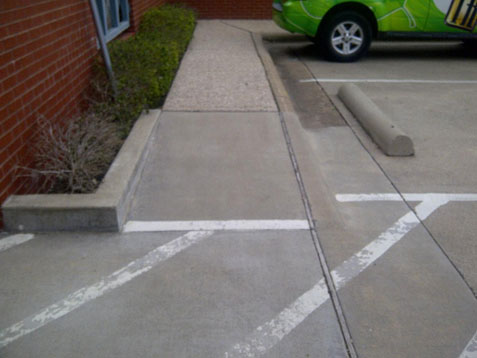
The picture above built in microwaves mounted above the 48″ allowable reach range. They added a counter top microwave that was not built in. This does not alleviate the lack of reach range.
Public Right of Way
The Public Right of Way guidelines (which are only proposed and have not been adopted), as well as municipalities and Department of Transportation may require that detectable warnings be provided at the bottom 24″ of the curb ramp. This will allow people that are visually impaired be aware that there might be a hazard beyond the texture.
The ADA does not have requirements beyond the property line. Therefore the public right of way does not fall under the ADA.
The Texas Department of Licensing and Regulation used to have a section in Chapter 68 which required detectable warnings at curb ramps within the public right of way, but they eliminated that in the most current version of the Rules. Click Here to see what they require.
TDLR no longer requires detectable warning at curb ramps at the public right of way.
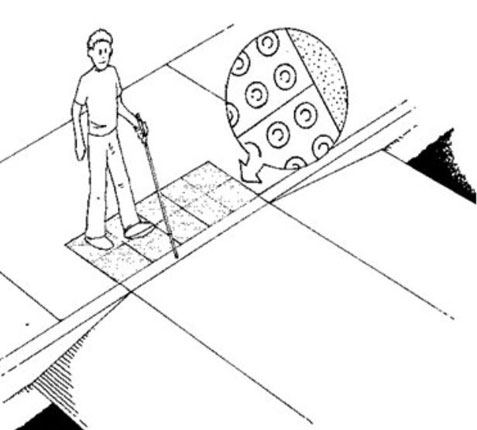
The figure above shows the requirement for detectable warnings listed in the Public Right of Way Guidelines
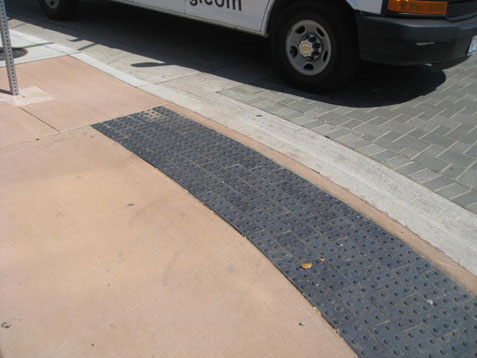
The curb ramp has detectable warnings per the Department of Transportation and the Public Right of Way Guidelines. Check your municipality to make sure what it requires
Tuesday, March 1st, 2022
Introduction:
I perform ADA, Fair Housing and Texas Accessibility Standards on site inspection and assessments every Wednesday. Some days I find unique conditions that I like to share with you so we can learn from them and be sure they do not happen to you also. This newsletter will give you some of my latest intersting finds.
Vision Lights at Doors
The ADA requires that all doors that require user passage comply with all the portions of the section 404. Door that reqired “user passage”
But are all doors required to comply? What about doors that are only used for employees? The doors shown below are into a commercial kitchen. The vision lights for doors that allow user passage must be mounted no higher than 43″ a.f.f., but these type of doors have the vision light mounted higher. Here is the standard:
404.2.11 Vision Lights. Doors, gates, and side lights adjacent to doors or gates, containing one or more glazing panels that permit viewing through the panels shall have the bottom of at least one glazed panel located 43 inches (1090 mm) maximum above the finish floor.
The vision lights requirement are for ALL doors that require user passage unless the room beyond is excempted (like IT closets or other machinery spaces). Employee work area doors must have the ability to approach, enter and exit, therefore those doors into employee work areas like commercial kitchens will also have to comply.
During one of my inspections, I went to a restaurant and they had the door into the kitchen with vision lights higher than 43″ a.f.f. The owner was confused. It is not so simple to understand why this door would have to comply, but keep in mind that the ADA protects persons with disabilities from discrimination at the work place. If a person in a wheelchair gets hired as manager, the vision light allows them to see inside so they don’t get hit by the door. Be sure to specify one of the doors with the vision lights lower.
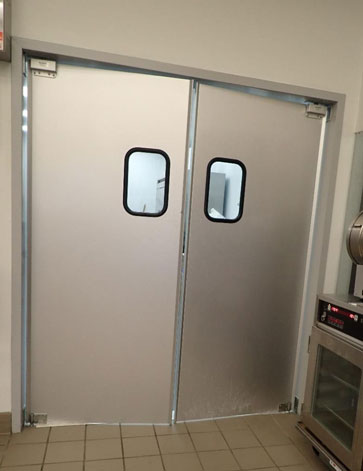
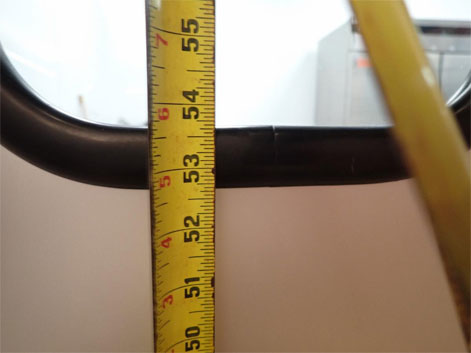
The picture above shows a commercial kitchen door with vision lights mounted higher than 43″ a.f.f. This is not compliant.
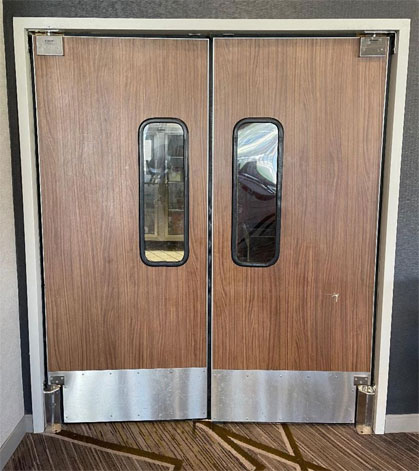
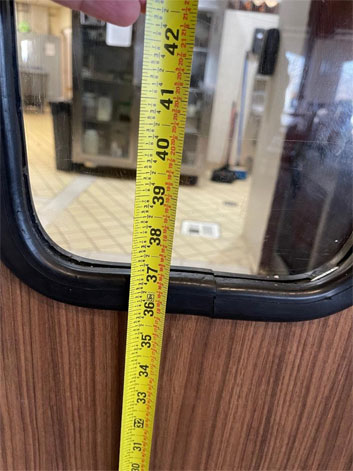
The picture above shows a commercial kitchen door with vision lights mounted lower than 43″ a.f.f. This is compliant.
Fixed or Built in elements
The ADA only deals with fixed or built in elements. At one of my inspections there was a break room with built in microwaves that were mounted higher than the allowable reach range. To solve the violation they added a microwave to the counter. This did not resolve the violation, because it is not a “built in” element and does not satisfy the requirement. Below is what the ADA states about what elements are scoped in the standards:
“Scope of coverage. The 1991 Standards and the 2010 Standards apply to fixed or built-in elements of buildings, structures, site improvements, and pedestrian routes or vehicular ways located on a site. Unless specifically stated otherwise, the advisory notes, appendix notes, and figures contained in the 1991 Standards and the 2010 Standards explain or illustrate the requirements of the rule; they do not establish enforceable requirements.”
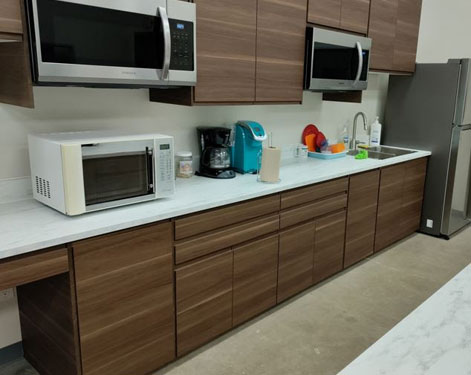
The picture above built in microwaves mounted above the 48″ allowable reach range. They added a counter top microwave that was not built in. This does not alleviate the lack of reach range.
Protruding Objects
There are rules in the ADA Standards that pertain to people who are visually impaired. Since they cannot detect objects mounted higher than 27″ a.f.f. we typically design and built the objects so that they are recessed or have some sort of cane detection. But in one of my inspections, the drinking fountain was recessed, but not far enough, so that the leading edge was still projecting onto the circulation path more than 4″
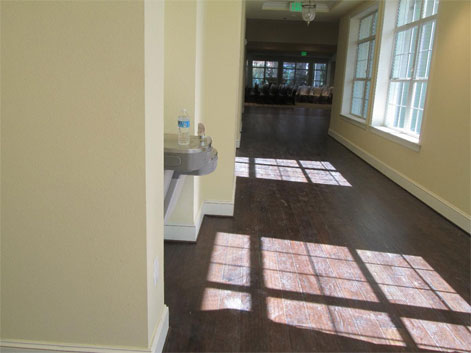
The picture above shows a recessed drinking fountain that is located in a corridor. But the leading edge still projects more than 4″ onto the circulation path and therefore was considered a violation of the protruding object rule
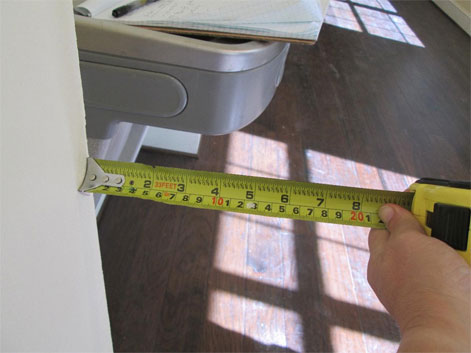
The drinking fountain projects 5″ ontothe circulation path














 Abadi
Abadi 






















































 .
.













